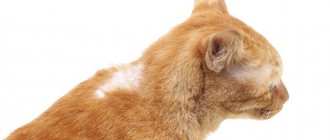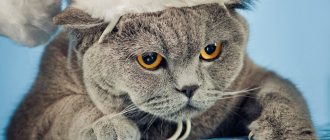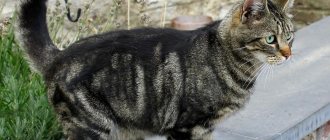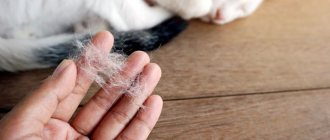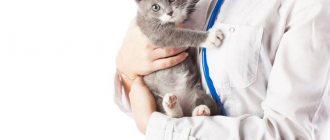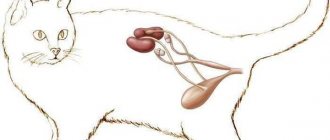In some situations, pet owners turn to veterinarians with complaints that the cat’s tail has become thinner at the base and has become covered with a layer of dense fat that is difficult to remove.
Cat owners are interested in what to do in such a situation, how to get rid of oiliness, and why blood may ooze from the affected areas of the tail skin. Most likely, in this case, the doctor will answer that the cat has a disease called “greasy tail.”
Causes
Disease on a pet's tail can occur for various reasons. Often these are: long-standing injuries, severe bruises, wounds, fractures or any other damage. Sometimes, but there are still diseases that are quite difficult to determine. These include: tumors, unknown neoplasms, eczema, osteomyelitis. Any of them requires high-quality qualified treatment in compliance with all requirements and recommendations of a veterinarian. Every loving owner should know why such diseases occur and how to deal with them.
© shutterstock
Greasy tail in a cat: treatment
After a visual examination, the veterinarian must prescribe adequate treatment in order to help the animal. Therapy includes
:
1 Treatment with shampoo with a keratolytic effect, specific shampoos that the doctor can suggest: “Lactaderm”, “DoctorZoo”, “Peroxiderm”. When purchasing, be sure to read the ingredients. There shouldn't be any birch tar there. As a rule, it is this that can cause severe irritation to the pet’s skin. Among other things, chlorhexidine may be prescribed, which will disinfect and dry the skin on the tail. As a rule, with a mild form of the disease, after bathing with a special shampoo, everything goes away on its own. 2Also, during the treatment of a cat’s greasy tail, the dishes from which
the furry pet eats play an important role.
Either ceramic or metal feeding utensils should be used. Also, for prevention, it doesn’t hurt to wipe your pet’s chin after every meal. 3In most cases, a greasy tail is considered simply a cosmetic defect that does not require urgent and special treatment. Topical medications (drops, ointments) are of little help in treating severe forms of the disease, since the cat licks them off very quickly, so oral antibiotics . Typically, treatment is required for 4-6 weeks. Also, in severe cases, steroid drugs that relieve inflammation are used for short-term treatment.
Treatment options
Treatment for a cat with “greasy tail” will most likely be lengthy and not the most pleasant for both the owner and the animal itself. If your beloved Scotsie or other breed just doesn't want to bathe, he'll need to be bathed regularly using a shampoo like Lactaderma, which contains lactic acid.
It promotes good washing of fur and skin without drying it out, and also helps to gently exfoliate keratin accumulations. After such care, even the laziest cat’s fur will stop getting greasy and become beautiful and fluffy.
If the problem is caused by high hormonal levels, the doctor will recommend castration or other procedures. If the anal glands are to blame, they can be washed or emptied manually. If the disease recurs regularly, the veterinarian will train cat owners to do this at home. If the disease is chronic or severe, surgery to remove the glands may be recommended.
As a general tonic, the veterinarian can give recommendations on the use of special vitamins, as well as change the usual diet.
In the presence of acne, increased keratinization, and blackheads on the skin, special shampoos are used. From a large list of such products, we can name Dermilen and Meladerm. They are aimed at treating oily seborrhea and can prevent the spread of the disease, prevent the infection from “settling” and the development of chronic eczema.
Treatment of a cat's tail can be complex and lengthy, but it must be done, since without proper attention to the problem, irreparable changes can develop, in particular, the cat can be left with a hairless tail, like a rat's.
A cat has a greasy tail: how can a veterinarian help?
The veterinarian will be happy to help solve such a delicate problem as a greasy tail on your favorite cat. Thanks to the most modern technologies, any analysis
You can now get it
in less than an hour
. The most professional and knowledgeable doctors will take care of your pet. Veterinarians act professionally and skillfully, trying not to hurt the furry creature. Please do not forget that before visiting the veterinary center you should under no circumstances wash the animal. This will help the doctor visually assess the condition, and also, if necessary, take a skin scraping.
Is it worth calling a doctor to your home if your cat has a greasy tail?
Many people think that greasy tail is a minor problem that is not worth bothering doctors about. However, if this condition significantly disrupts the cat’s comfortable life, then without hesitation, call a doctor at home
. This is much more convenient than wasting time visiting a veterinary center and standing in line. Calling a doctor to your home will also help you carry out all the necessary procedures in relative peace, since there is no additional stress associated with visiting a veterinary office.
After you leave a request on the website, our manager will contact you very quickly to confirm the call, as well as to set the symptoms. When the call is confirmed, in less than 40 minutes our doctor will come to your aid, who is already on site and will closely examine your pet. After an in-person examination, a conversation with the owner of the animal is also required.
The cat has a greasy tail. What to do after a visit to the veterinarian
- At first, of course, stay with your pet, calm her (him). This will help the animal feel confident and very calm.
- After the animal has calmed down, you can go to the veterinary pharmacy for the shampoo prescribed by the doctor, as well as ointments, if they are on the list.
- You should not self-medicate and hope that the greasy tail will go away on its own. It would also be very reckless to try human shampoos, recipes for acne and oily skin on a cat. You need to remember that in front of you is a completely different organism, with its own oddities and characteristics. During the treatment period, you should exclude all goodies and harmful things from the cat’s diet, no matter how much you would like to treat your pet to support him.
Dear owners! Carefully watch your kittens, male cats, because their life and health are in our hands! Therefore, if you notice at least some deviation from the norm, you should contact “I-VET” as soon as possible. Moreover, we provide such a convenient service as a doctor visiting your home, and this is just a godsend for extremely busy cat owners. Be sure that the cat will say: “Thank you!” for the timely assistance provided!
Common diseases
Vertebral caries. The main cause of the disease is a lack of calcium, which occurs as a result of impaired metabolism. If you feel a cat's tail, you can feel formations on it; they resemble beads strung on a thread. If left untreated, the tail will completely lose its mobility, stop bending, and the pet will feel discomfort all the time.
Osteomyelitis is a disease that is caused by inflammatory processes in the bone marrow of the tail. This leads to serious injuries and infectious diseases. The most important symptoms are: lameness of the cat, pain when pressing the tail, lack of appetite. Sometimes, the presence of purulent ulcers may indicate that a sore has appeared.
Dangerous skin diseases of cats
Ringworm
Symptoms: hair loss in certain areas of the skin, peeling, the appearance of strange scales, sometimes purulent wounds. Your cat may itch, but ringworm usually does not cause itching.
Demodicosis
A serious disease caused by microscopic mites. It is highly contagious and develops rapidly. The main symptom is severe, constant scabies, the skin becomes covered with red spots. It starts with the head, ears. Without treatment, it quickly spreads to other areas of the body, appearing consistently in the armpits, on the folds, and at the base of the tail.
Factors predisposing to the appearance of demodicosis are improper feeding, maintenance, lack of a number of B vitamins, vitamin A, E, and worms.
Eczema
The main symptom of eczema is a weeping surface of the skin. The cat scratches the affected area, redness and nodules appear on the skin. The general condition changes: a fever develops, the cat loses weight, and kidney problems begin.
Based on skin scraping tests, your veterinarian will rule out other skin diseases and prescribe antihistamines. It is not recommended to treat the cat yourself, as any incorrect treatment can cause additional complications.
Dermatitis
Dermatitis is dangerous due to its unpredictable manifestations. If left untreated in time, they can severely undermine the animal’s immune system.
Bedsores
Necrotic destruction of a cat's skin due to prolonged lying in one place. Manifested by tissue necrosis, death of skin cells. It is observed in sick animals that are forced to remain in one position for a long time. Symptoms: pain when touched, decreased temperature of the dying area, color change, appearance of ulcers. Prevention of the development of bedsores is simple - turn your pet over more often in the postoperative period, do not let him sit on the injured limb for a long time. Treatment comes down to treating wounds, dressings, and removing dead tissue.
Associated with viral infections
Some feline diseases lead to the development of skin problems. For example, with leukemia
the integument is especially severely affected - abscesses, neoplasms, and wounds occur.
Immunodeficiency in cats
causes chronic otitis media with damage to the skin of the ears, and numerous pustules (vesicles with pus) appear on the body. causes damage to the skin of the paw pads and around the nose.
It is important to promptly seek help from a veterinarian to determine the cause of the skin disease. The specialist will determine the main cause of the soreness and prescribe adequate therapy.
The cat scratches itself periodically, but looks quite well. However, once again stroking the pet, the owner notices the cat’s sores
.
What are the reasons why, seemingly asymptomatically, a cat develops sores
?
Among the broad picture of feline skin diseases, a number of particularly common ailments can be identified, as a result of which the cat develops sores.
Symptoms of the disease
It is believed that cats are more susceptible to this disease than others, but it can also occur in cats. Moreover, some breeds are more at risk than others of developing such an unpleasant and difficult-to-treat disease. For example, the Scottish Fold cat is often noted to have a hard tail, while according to breed standards its mobility is especially valued. With such a disorder, a “greasy tail” may also occur.
But the Persian cat is more susceptible to acne, which causes her not just discomfort, but can cause a serious illness. In addition, representatives of any breed, and even outbred cats, can have a fat tail.
In short-haired or “hairless” breeds, it is much easier to detect such a defect, but it is much more difficult to detect it in an animal with a luxurious, bushy tail. Most often, it is discovered by chance, when the process has already started and done its dirty deed.
Greasy tail syndrome is accompanied by the following symptoms:
- The fur at the base of the tail becomes very greasy, covered with thick secretions, which are very difficult or impossible to wash off using simple methods, at least from the first approach.
- On the skin at the base of the hairs you can see tubercles, which can be inflamed, covered with rough scales, and a purulent crust.
- When the disease is advanced, a whole scattering of inflamed pimples or scars from scratching may be found on the skin.
- When the fur suffers from greasy hair, it can break off at the base, leaving the affected area exposed or looking as if the hair has been clipped or pulled out.
- When the anal glands are inflamed, the animal tries to get rid of their excess contents by crawling with its backside on the floor, and sometimes on the carpet.
- With acne, a greasy yellowish spot first appears on a cat's fur, then a “black dot”, and in the absence of care and treatment, a hard crust forms, under which there may be an inflamed or abscessing acne.
Seborrhea (dry and oily)
If your pet suddenly starts smelling like a dog, so much so that it becomes difficult to be in the same room with the cat, do not rush to accuse him of being unclean. It is possible that your pet suffers from seborrhea. This is a disease characterized by impaired sebum secretion. If too much of it is secreted, then seborrhea is, accordingly, called “oily.” With insufficient secretion of sebum, a dry type of the disease develops.
Veterinarians are still arguing about the causes of the disease, but to this day many cases must be considered idiopathic, since not a single study has helped to identify a single predisposing factor. In cats, the most common is the “fat” variety.
The clinical picture is quite characteristic. In addition to the unpleasant odor already mentioned above, numerous dandruff appears on the animal’s skin and fur (with the dry variety), or the cat’s tail resembles an unsightly icicle. In the latter case, this happens because the sebum released in incredible volumes simply sticks the hair together.
The intervals between relapses (with proper feeding and good living conditions) can reach several months.
The main predisposing factors are:
- Temperature changes, as well as keeping the cat in rooms with excessively dry air (which is typical for all apartments with central heating).
- It is believed that one of the main reasons for the development of seborrhea in many cases is a variety of allergic reactions.
- The same can be said about diseases of fungal etiology. Pathogenic fungi and yeast have a very bad effect on the condition of the skin.
- “Raw” or “oily” seborrhea is a common consequence of severe hormonal disorders. In particular, it often appears with problems with the thyroid gland.
- Obesity. Firstly, in cats it can also be a consequence of problems with the endocrine glands. Secondly, a “swollen” cat is simply physically unable to take proper care of itself, which makes it much easier for pathogenic fungi to invade its skin. In addition, in such cases, the animal may not have seborrhea, and greasy skin is only a sign of its extreme neglect.
- Diseases of the gastrointestinal tract. If the body does not receive the proper amount of nutrients, micro- and macroelements, the likelihood of developing any diseases becomes many times higher.
- Skin diseases of tick-borne etiology. As a rule, the activity of these parasites leads to the development of a dry type of the disease: mites, gnawing through the outer layers of the skin and actively developing in them, interfere with the normal functioning of the body.
Symptoms and treatment
The symptoms are quite specific, and therefore, as a rule, there are no particular difficulties in identifying the disease. First of all, it is the tail that is affected, which as a result either becomes covered with dandruff, or takes on the appearance of a “greasy icicle.” Abundant dandruff rashes can be found in places where the animal likes to rest; they also become heavily greasy in the case of the oily type of pathology.
Another characteristic sign is very specific, sharp and extremely unpleasant. Experienced owners or veterinarians are able to make a diagnosis as soon as they smell this “aroma.” Note that seborrhea itself does not produce any odor - it is a consequence of the activity of secondary microflora.
As for treatment, it is primarily aimed at eliminating the identified root cause of the disease. Idiopathic seborrhea is treated with special shampoos, which can be purchased at any large pet store. We would recommend consulting with your veterinarian first. It is better when the shampoo is selected by an experienced specialist.
The following products have proven themselves to be effective:
- "Tea tree". It degreases the skin well and has a pronounced anti-inflammatory effect.
- Additionally, any antiparasitic shampoo. It is used in cases where the disease is caused by the activity of fleas, ticks, or other ectoparasites.
- Accordingly, when the disease is fungal in nature, shampoos with an antifungal effect are used.
Tail hair loss
The following symptoms symbolize this problem::
- the presence of bald spots;
- on the upper part of the tail, at its base, the hair has become greasy, greasy and constantly rolls down;
- Under the fur you can find a discharge that is oily and brown in color.
The cause of tail baldness may be a disruption in the functioning and functionality of the glands that produce fat. If fat production is disrupted, then the above changes occur, the skin balance is disrupted and the pet suffers.
Taking care of our pets
Every cat owner should have a clear idea of what diseases he may encounter in his animal. Veterinarians often advise washing cats' anal openings with soap and water. This procedure has a stimulating effect on the anal glands, helping them to cleanse themselves. We also appeal to attentive owners who take their pet for examination at an animal care center - remind the veterinarian about a routine examination of the secretion sacs.
Since the animal experiences pain and shows aggression when performing manual manipulations to remove secretions, it is recommended to contact a specialist. At the Ya-Vet help center, experienced doctors will show you professional, fast help at low prices for your pet. We show love to animals by keeping them healthy!
Dog owners are well aware of possible problems with the anal glands. These are the characteristics of the canine family. However, there is a lot of information about cats. Inflammation of the paraanal glands in cats is not such a common occurrence, since canines and cats are anatomically and physiologically different, although both are human pets.
conclusions
These are the main reasons why a cat's fur may look greasy and unkempt. Some of them go away on their own; in other cases, veterinary intervention will be required. With competent actions by the owner, if oily fur is detected on a pet, the problem can be eliminated in just a few days, returning the animal’s fur to its former shine and beauty.
The problem of oily fur goes away within a few days with the correct actions of the owner.
Ulcers
More often, ulcers occur in short-haired four-legged friends. They can appear along the entire length of the tail, often affecting the root, and this can cause necrosis of the tissues and vertebrae of the tail.
An ulcer on the tail requires serious treatment and attention from the owner. If a crust has formed on it, then it must be removed from there and the wound must be cleaned of suppuration. Be sure to treat everything with an antiseptic for cats. Also, it is worth treating it with ointment (Vishnevsky, streptomycin) and applying a bandage.
© shutterstock
In advanced cases, the cat may develop gangrene, blood poisoning and serious consequences.
Advanced cases and their treatment
Excessive oily secretions in Maine Coons indicate poor health. The most common manifestations:
- ulcers;
- baldness;
- redness;
- wen;
- ichor;
- blood at the scratch site;
- tissue necrosis (very rare).
With such symptoms, the behavior of the sick animal also changes. It becomes irritable, may meow nervously, eat poorly, bite and tear its tail with its paws. Together with cloudy discharge from the eyes, they indicate:
Hypersecretion of the sebaceous glands is detected in most cases when visiting the clinic
It is important to maintain Maine Coon hygiene, but not to overuse grooming products and frequency of treatment. You can learn the correct actions from masters from grooming salons and breeders
Castration of a cat eliminates the vast majority of problems with a greasy tail.
Fractures and other injuries
Tail injuries are the most common disease. The most common problems with the tails of cats are injuries, namely dislocations and fractures, etc. Fractures can be closed or with open wounds. In the place where the tail is broken, broken or bruised, in most cases a tumor forms, in the place of which the animal experiences pain when touched. If it happens that you find an open wound, then be sure to go to the veterinarian, not forgetting to first treat the wound with any antiseptic, for example, hydrogen peroxide. This will help avoid infection. If the tail is severely bruised, or you suspect a closed fracture, an ice compress should be applied to the injured area, which can be done using a heating pad or a regular cloth. Ice will relieve pain and reduce swelling. At the veterinary clinic, you will definitely be asked to take an x-ray of your pet’s tail, and based on the image obtained, he will be given the necessary assistance and further treatment will be prescribed.
There are pussies that cannot be scared by tail diseases.
If you find an error, please select a piece of text and press Ctrl+Enter.
Drugs used
To successfully treat an animal, the use of any one remedy is not enough. Therapy must be comprehensive. Medicines should be used both internally, to suppress microflora, and locally.
Ointments
Ointments and liniments have a fatty base, which contributes to:
- rapid absorption of the active principle;
- preventing drying out of serous and mucous membranes;
- softening of tissues, as well as dried “crusts” and their rejection.
If there are no wounds or tears, there is no point in using ointments. Some substances can be absorbed through the skin, but no strong effect is felt.
If there is an abscess or purulent cavity, then applying ointments will help relieve inflammation, but at the same time it is necessary to remove the purulent masses and excise the pockets so that the contents do not linger.
The inconvenience of using ointments for the sub-tail area is that the cat sits down and wipes the ointment on the floor and bedding.
It’s a completely different matter when the drug “Olazol” is used. When shaking the bottle, a foamy mass forms. Through the nozzle it can be easily inserted into the lumen of the rectum. By doing this regularly, you can quickly create the necessary concentration of the active principle in the tissues and relieve inflammation. The base is chloramphenicol and sea buckthorn oil. The drug is effective for paraproctitis and the cat recovers quickly.
The following can be used as ointments:
- levomekol;
- levosin;
- chloramphenicol - gel;
- syntomycin liniment;
- gentamicin ointment.
The ointment should be applied at intervals of 1-2 hours into the wound cavity. If there is no wound, then apply the ointment alone to a cotton swab and insert it into the cat’s rectal cavity. You should change your tampon 2 times a day.
Antibiotics
A course of antibiotics is necessary to suppress the infection and lasts 5-7 days, depending on the severity of the process.
The most effective drugs are:
- cephalexin. If the drug is in capsules, then the gelatin base contains a powder that is very easy to dose. For an average cat, you can take 1/10 of it, mix it with minced meat and apply it to the root of the tongue. The tablet form is turned into powder or 1/10 of the tablet is broken off and served to the cat. The drug is well absorbed and retained in soft tissues and acts against many microorganisms. The drug is administered 2 times a day in a mixture with food;
- ciprafloxacin. The group of fluoroquinolones to which the drug belongs is able to quickly cope with the onset of infection and relieve inflammation from soft tissues. The drug is in tablet form. For a cat, the tablet is divided into 10 parts and placed in the mouth in one part in the morning and in the evening.
Rectal suppositories
The described pathology is localized in the rectum and the use of rectal suppositories is advisable.
The following drugs may be most effective:
- “Ichthyols”, based on ichthyol;
- “Propolis” containing propolis;
- "Proctosedil", with antibiotics and hydrocartisone
- "Olesthesin" with sulfonamides and sea buckthorn oil.
Suppositories are administered 2 times a day after bowel movements.
Prevention
- Sterilization helps to avoid problems with the greasy tail by ensuring a calm hormonal balance. But it is worth noting that many uncastrated cats never encounter such a dermatological problem.
- A balanced diet and timely consultation with a specialist at the first signs of the disease will help prevent hyperplasia of the sebaceous glands. Preventing obesity throughout a pet’s life and caring for its fur is something any owner can do.
Why does the hair on my back get oily?
This symptom may be a sign of the development of seborrhea, a skin disease that appears due to a violation of the excretory function of the sebaceous glands. This happens due to improper care.
Frequent bathing, washing with shampoos not intended for animals, liver dysfunction are the main factors that provoke excess sebum secretion.
A lack of vitamins and minerals can affect the condition of a cat's hair. It is worth diversifying your pet's diet, including lean meat and rice, and introducing vitamin supplements to improve the quality of the coat.
